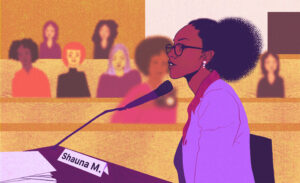Understanding The Hyde Amendment: An FAQ
The Hyde Amendment is an oppressive federal law that bars people from using government insurance to pay for abortions.
Since the amendment was passed in 1976, it has blocked millions of pregnant people every year from getting the abortion they want or need. Access to abortion has never been equal. However, Hyde’s dangerous impact increased when the Supreme Court overturned Roe v. Wade in 2022.
NNAF and Our Allies Want The Hyde Amendment Repealed.
Read these facts about the harm Hyde causes and understand why.
The Hyde Amendment affects people who rely on government insurance. That group includes folks enrolled in Medicaid, Indigenous people enrolled in Indian Healthcare Services, disabled people, people serving in the Peace Corps, federal employees and their dependents, military personnel and their dependents, veterans, and people living with low incomes.
The Hyde Amendment harms people who already have difficulty accessing healthcare, especially disabled people, people in the LGBTQ+ community, young people, and immigrants.
But the biggest impact of the Hyde Amendment falls on those facing systemic racism and economic injustice. Particularly Black, Latina*, and Indigenous women**, who earn only slightly more than half the wages of white men and are more likely to be uninsured.
*Latina is used here to reflect the language used in sources.
**NNAF knows that people of all genders need and want abortions. We hope statistics will report a fuller range of experiences in the future.
The Hyde Amendment stops federal funds from being used for most abortions. But there are exceptions for cases of rape, incest, or when the pregnant person’s life is in danger. These exceptions can change from state to state.
No. The Hyde Amendment is not permanent. It needs to be renewed every year. U.S. politicians continue to vote to keep it in the federal budget.
The Hyde Amendment is a federal law that applies to all states. Even if a state has laws that protect and allow abortion, the Hyde Amendment can still make it hard for some people to cover the cost.
Some states have chosen to use their own funds to cover abortion services for Medicaid recipients. Currently, 19 states provide abortion coverage for people enrolled in Medicaid.
Visit Abortion & Medicaid to learn more about Medicaid abortion coverage in your state.
Use this Interactive Map to stay up-to-date with current state laws and policies.
After the Supreme Court overturned Roe v. Wade in 2022, the damage done by the Hyde Amendment became even clearer. As soon as Roe was reversed, many states enacted “trigger bans” restricting or eliminating abortion access.
These anti-abortion laws force pregnant people to travel longer distances for safe, legal abortions. This increased travel can result in higher costs for transportation, lodging, food, and other travel expenses, as well as the need to pay for extra childcare and take more time off from work.
Added costs can lead to tough choices for people already struggling financially. To afford abortions, some people may have to sell their belongings, miss rent payments, or go without food. Others may never be able to gather the money they need to pay for an abortion.
When this happens, many are forced to carry pregnancies to term unwillingly or seek unsafe, illegal ways to get the abortion they want and need.
That’s why we must repeal the Hyde Amendment.
You Can Help Overturn the Hyde Amendment
Angered by what you read? Here are 5 things you can do to help overturn the Hyde Amendment.
Learn More.
Check out this Guttmacher Institute Fact Sheet for more information about Hyde.
Get the News.
Sign up for emails from NNAF and the Center for Reproductive Rights (CRR). Stay updated with current Hyde Amendment developments.
Talk to Your Network.
Talk with your family and friends about the harmful impact of the Hyde Amendment.
Contact Your Electeds.
Tell your elected representatives you want the Hyde Amendment repealed.
Stay Engaged.
Donate to abortion funds. Join the Reproductive Justice movement and build power with other pro-abortion activists and advocates.
NNAF Is Working to Repeal Hyde
The National Network of Abortion Funds (NNAF) is organizing to repeal the Hyde Amendment. Together, we’re spreading the word about the harmful impact of the Hyde Amendment and building power behind pro-abortion legislation like the EACH Act.
“At the National Network of Abortion Funds, our member funds see firsthand how the Hyde Amendment has disproportionately harmed abortion fund callers, many of whom are enrolled in Medicaid or uninsured, unemployed or have limited employment.”
Oriaku Njoku, former Executive Director of NNAF
